How ‘Ralph Breaks the Internet’ Transforms the World Wide Web Into a Fully-Realized World
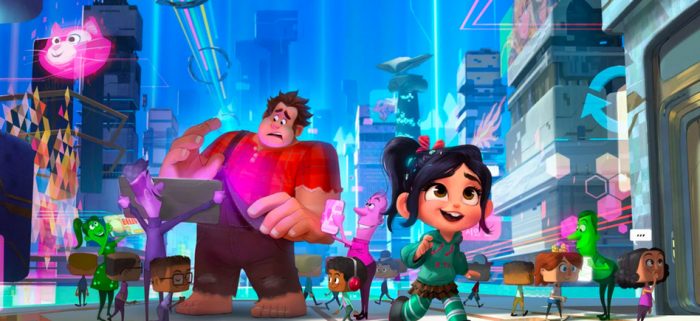
Ralph Breaks the Internet takes John C. Reilly’s good-natured video game “bad guy” out of the arcade and drops him into the world wide web. But the filmmakers and animators and designers at Disney Animation faced a challenge: how do you transform the internet into an actual place that can be occupied by characters? How can something abstract become the setting of an animated movie?
Here’s how the production found the story for Ralph Breaks the Internet and built this in-depth new world around it, a process that nearly broke render computers and went through numerous iterations.
The Story So Far
Before we talk about the design of the world of Ralph Breaks The Internet, we need to give you the basic set-up of the story. It starts where things left off in Wreck-It Ralph. Vanellope and Ralph have remained friends, spending time together outside of their games when the arcade is closed. One day, their after-hours ritual is interrupted by a plugin alert: something new has been installed in Mr. Litwak’s Family Fun Center & Arcade – something called WiFi.
The next day, a kid playing the Sugar Rush game ends up breaking the steering wheel off the arcade console. The game has long been discontinued, and the manufacturer is out of business. The kids find a replacement part on eBay, but even with the increased popularity of Sugar Rush, the price is more than the game makes in a year. So Mr. Litwak decides to pull the plug on the game, which leaves Vanellope homeless.
Ralph offers Vanellope a place to stay inside the Fix-It Felix game, building her a pillow fort on top of his building. She’s devastated that her game is gone forever. If she’s not a racer, what is she? She begins glitching and decides she needs to be alone and storms off. Ralph gets an idea to sneak into the internet router in the arcade to get to eBay to obtain the replacement part.
Ralph and Vanellope travel to the router for the first time. It turns out to be an unremarkable box, which Ralph remarks is not as impressive as it was described. The movie cuts to inside Litwak’s small office in the arcade, with him figuring out how to turn the router on using his old iMac. As he presses the button, the router box transforms into a green high tech room like something out of Tron. Litwak’s avatar appears in front of them inside the router and walks into a portal, and they follow him through the tunnel, shooting through the cord, into the telephone wires, eventually into the internet itself – a huge digital city. They end up in something that looks like a huge airport terminal.
The search bar Knowsmore sends them on a journey to eBay, a cavernous building filled with rows and rows of auctioneers, where there are tons of cubicles, each with their own auctioneer and Net Users watching. Among the items we see on auction include a Dorito chip with the face of Beyonce and a velvet painting of a kitten. Each row in the eBay headquarters has a sign, with the whole building organized by section, almost like a supermarket. They go to the video games aisle and start bidding on the steering wheel. Vanellope bids $1000 and Ralph starts bidding against her, clearly not smart enough to understand the concept of an auction. The steering wheel ends up selling for $27,001, and they get a voucher to bring to checkout for processing.
At the checkout counter, they are asked for a credit card, which they clearly don’t have. So Ralph starts making up numbers. The “Netizen” at the register realizes that they don’t have payment and tells them that they have 24 hours to pay before they forfeit the item.
How are two video game characters from a small arcade going to earn the money? They meet a character named Yesss at BuzzTube who has an idea. With only eight hours left before they need to pay the eBay bill, Yesss sends Vanellope to a fan site to market the viral videos she and Ralph created. The place she is sent is a fan site called OhMyDisney.com, which is described as everything Disney all under one roof. It is here that she somehow ends up in a dressing room with all of the Disney princesses, a scene that has been shown off at conventions and in the trailers.
The Earlier Versions of the Story
The treatment for this film began in 2014. The earliest version of the script had Vanellope getting sucked up into the internet – she had her own website called Vanellope.com, and she was giving a TED Talk, and the character changed. Ralph mistook going “viral” for being a virus, and internet security locked him up in jail. He broke out of jail with Knowsmore, who was a much more prominent character in that early version of the story – he was a broken search engine. And Ralph and Knowsmore were partnered up in a search for Vanellope, who was changing dramatically, going from the Vanellope we know to a dolled-up internet celebrity who forgot who she was.
A later version of the script flipped that idea, with Ralph becoming enamored with himself, drunk on his own fame and popularity. For some of those early versions of the story, there was a villain character, an internet supercop named Bev, which was like McAfee or Norton Antivirus. However, the story team eventually came to the realization that this is the story of the two of them, Ralph and Vanellope, who go to a big city. One loves it, the other doesn’t care for it, and they realize they have two very different journeys ahead that will test their friendship. This is the version that became the movie.
Developing the World of the Internet
Filmmakers Rich Moore and Phil Johnston say the reason they found to do a Wreck-It Ralph sequel was the comedy and conflict that comes from transporting our main characters from the small town of the arcade into to the virtual city of the internet.
The big challenge in developing this movie was to design an animated version of the internet that felt like the internet we use every day. On Zootopia, Moore and Johnston took their development team to Africa, on Moana they went to the South Pacific, and for Ralph Breaks the Internet, they took a luxurious research trip down the street to One Wilshire Blvd, a 30 story building in downtown Los Angeles which houses most of the internet connections in the western U.S. One-third of internet traffic from the U.S. to Asia passes through the structure.
As you might expect, the facility is filled with wires and boxes from top to bottom, which they used as inspiration for their virtual internet city. In the earliest animation tests, the internet city featured streets that look like the wired lanes in the building. They also photographed panels on computer motherboards and chips to help inspire the internet world’s city grid.
The Internet is a three-dimensional vertical city, which means it functions on a different level than our real-world cities. For example, there are sidewalks on different levels and different ways into every building, envisioned like there are different ways into every website. The design language uses the 45-degree angles that you would see on a motherboard. The filmmakers populated the street with signage and holograms to add charm and color. There are other small touches, too: if you enter a travel website building, you are handed free cookies.
The Internet Hub
Ralph and Vanellope arrive in the internet via a place called the Internet Hub (pictured above in concept art), which is designed to look like one of those huge futuristic international airport terminals. In the real world, if you wanted to send a lot of data through fiber optics, you would break down the data into different colors. This was the inspiration for the color guided systems that you see the characters land on in this scene. The platform itself is inspired by the undersea cables that connect the internet between continents.
Continue Reading The World of Ralph Breaks the Internet >>
The post How ‘Ralph Breaks the Internet’ Transforms the World Wide Web Into a Fully-Realized World appeared first on /Film.
from /Film https://ift.tt/2ArAixN
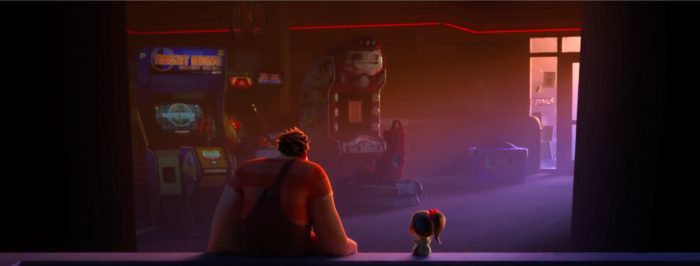
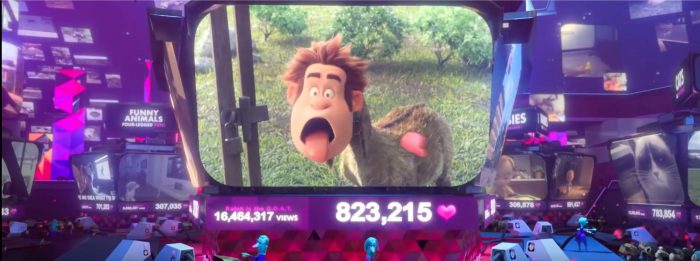
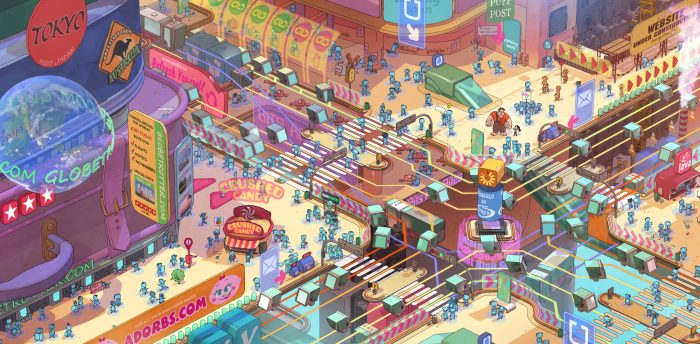
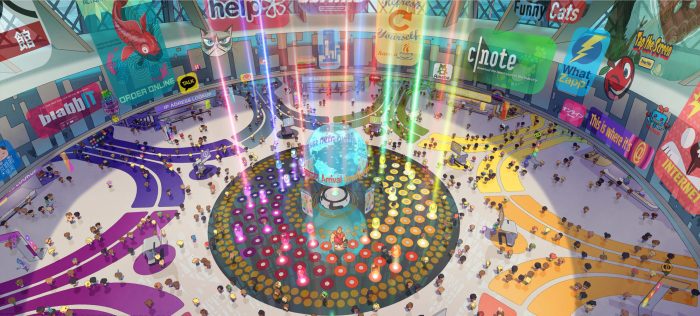
No comments: